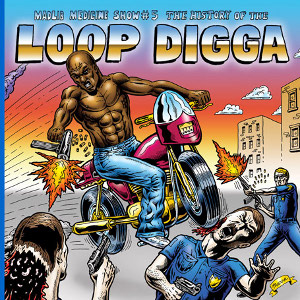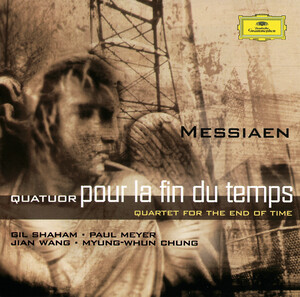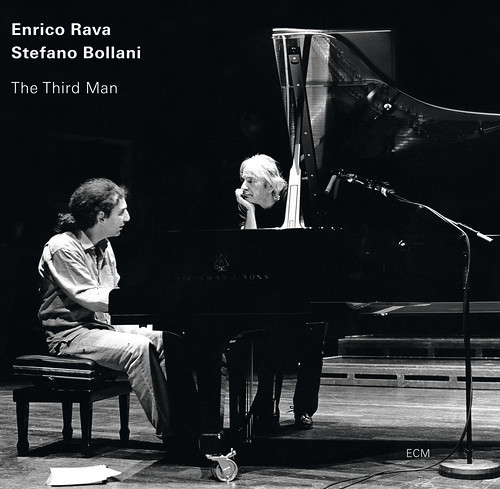10. Keith Jarrett & Charlie Haden - Jasmine

A quick glance at this deceptively simple album cover may lead many to see nothing more than a couple intersecting plane figures. Look a little longer however and you notice that the design is more naturally interpreted as the result of one continuous line motion - it actually cannot be broken down into two complete, overlapping rectangles. I smell an analogy. The music on this album, too, is deceptively simple. Keith Jarrett and Charlie Haden play so straight-ahead throughout
Jasmine that it could have been recorded in the early '60s (except that a few of their song choices hadn't been written yet). However, there is a depth of communication and sensitivity of musicianship present that is rarely heard in jazz of any period, except from total masters of the art. This music cannot be effectively broken down into two complete, overlapping piano and bass parts.
Eschewing all pyrotechnics and showboating, Jarrett and Haden offer a revitalization of one of my favorite jazz formats: the stripped-down deep ballad. It had been three decades since the two played music together before
Jasmine, but each is such a consummate musician individually, and each is so concerned with subtlety and refinement in particular, that their long time apart did nothing to affect their compatibility. They sound like old friends playing from the heart. If Jarrett takes somewhat more time in a leading position throughout, Haden makes the deliberateness of his understatement clear in his solos, which never once call special attention to technique or speed. All the delicacy is called for, as Jarrett explicitly writes that this is nighttime music for lovers - but it's also anytime music for the self-reflective. Anybody who appreciates the 1960s recordings of Bill Evans (
Portrait in Jazz,
Waltz for Debby,
Moon Beams,
Undercurrent and a lot more) should make it a priority to hear
Jasmine, especially Jarrett & Haden's contrapuntal cover of Evan's jaunty and cool "No Moon At All". Without any uninspired moments, this is the most intimate and straightforwardly beautiful recording Keith Jarrett and Charlie Haden have released in a long time, together or apart.
9. Kayo Dot - Coyote

It's becoming increasingly hard to describe what kind of music Kayo Dot make. From the metal roots of their progenitors maudlin of the Well, through four LP releases and several changes in personnel, the band has evolved past the point of genre classification. I like the non-descriptive umbrella "new chamber music" for their third album
Blue Lambency Downward and their latest,
Coyote. The instrumentation includes bass, drums, vocals, violin, trumpet, saxophones, and synths - and almost no guitar, a significant choice for a group that's been moving further away from their aforementioned metal roots.
What unites all of their albums is the presence of (melo)drama: concept-driven narrative arcs, references to the occult, dark and often dissonant instrumentation, and an air of total seriousness. Actually, moments of
Blue Lambency Downward reveal the band's unique sense of humor, but there's nothing funny about
Coyote, except maybe its name. The story behind the album was developed by Yuko Sueta, artist and close personal friend of group-mastermind Toby Driver, during the last stage of her life; sadly, she lost a battle with breast cancer. Musically it's the band's most unrelentingly heavy and pitch-black album to date, heavily influenced by '80s goth rock bands like Bauhaus and Faith and the Muse. Driver also acknowledged another interesting influence on the album,
Herbie Hancock's Sextant. At no point would I really call
Coyote "jazzy" but there are definitely places where the trumpet and sax arrangements recall Eddie Henderson's colorful solos, and this is also the most rhythmically charged, at times almost groovy Kayo Dot album.
Coyote is the band's shortest LP at a little under 40 minutes, and given its intensity and complexity that's not a bad thing. "Calonyction Girl" opens very strongly with menacing gestures from the violin, bass and drums; rarely have I heard bass harmonics sound so sinister. Driver quickly brings his voice to the forefront with pained, elongated phrases in fluid rhythm. After three minutes the song picks up momentum and becomes more rhythmically defined, ultimately building to a crushing odd-meter vamp that could be Kayo Dot's spin on "Hidden Shadows" (Herbie Hancock,
Sextant). The song also features one of the band's most surprising and lovely moments as it deceptively closes on a totally unexpected note of joy, with an extended major chord.
Continuing with a song-by-song analysis would result in an overly long review (not to mention spoil all the album's nice surprises), so suffice to say that the rest of the material maintains the standard of excellence set by "Calonyction Girl", though there are no further respites to happiness. The brilliant compositional arrangements throughout deliver fear, anger, sadness, beauty and wonder with an intensity few bands can match, and really, no other bands I know of are even trying to meld popular heavy music with 20th century avant-garde techniques in a remotely similar way. Kayo Dot are certainly a one of a kind group and they keep churning out masterpieces without repeating themselves.
8. Supersilent - 10

Supersilent's tenth album marks a very different direction for Deathprod, Arve Henriksen and Stale Storlokken. Lacking a drummer, the band has turned to increased harmonic sophistication and textural diversity to hold the listener's attention as they explore the infinite possibilities of free improvisation. The brief 10.1 begins with a piercing sustained trumpet note from Henriksen, over which Storlokken scatters some clear high piano notes. Storlokken harnesses chromaticism beautifully without giving a sense of total atonality, and the stark opener gives the impression of a dirge or elegy as Henriksen's tone takes on greater inflections of pain. Quite suddenly this melodic start completely gives way to texture, as the creeping fog of 10.2 fades in and Deathprod weaves a noxious mist with his one of a kind "Audiovirus", an amalgamation of signal processors. No band communication is apparent on this track, but it is effective ambient music. 10.3 and 10.4 return to the instrumentation of the opener plus electronics, with Storlokken on piano playing his most harmonically daring material to date. Apparently he was influenced by the compositions of Gyorgy Ligeti for these sessions, and one can definitely hear the impact of the 20th century avant-garde in general on his playing. Whereas previous Supersilent albums tended to be on the harmonically static side, generating interest mainly through dynamic variation,
10 features frequent distant modulations, chromaticism, artificial scales, and overall a much more impressionistic and unpredictable sound. When Storlokken untimidly lands on a surprising chord, the other players react and adjust immediately so nothing sounds like a mistake.
On 10.5 Supersilent work with bowel-rumblingly heavy drones and harsh noises reminiscent of their earlier material from
1-3, evoking the slow plod of some kind of megalithic golem bent on breaking stuff. It's an unexpected turn on this album, but a welcome switch to a sound many have come to expect from the band: thick, with a directly gutsy and aggressive attitude. This doesn't develop for long though, as 10.6 bends back in the opposite direction to textural sparsity and lovely diatonic melodies from the trumpet and a Brian Eno-esque wobbly keyboard sound. Beautiful melodic phrasing continues with the next two tracks; 10.7 is a dreamlike interlude for piano and trumpet with crystalline, pointillistic piano lines that are chromatic yet strangely consonant, and 10.8 - the longest track and functional centerpiece of the album - is arguably the most earnest and lovely piece the band has ever recorded, like a hymn on the sadness of existence, with Henriksen displaying the heights of his lyricism.
Things take another sharp turn with 10.9, another standout track and a return to Deathprod's thick ambient textures, this time more in the hazy extraterrestrial vein previously explored on
6 (probably Supersilent's most consistent, best album, and for me one of the absolute greatest records of the 2000s). Geologic bass tones mix with subtly shifting drone pads and bleeping alien signal transmissions to give a sonic picture of lonely beings marooned on an uncharted planet. Contrasting greatly with this is 10.10, the humble jewel of the album, less than 90 seconds of exquisite guitar, trumpet and piano interplay around a major triad. Yet another curve ball is tossed at the listener with 10.11, the fifth track on
10 under two minutes long. Here (and only here) percussion and repetition are the dominant elements, with a glitchy percussive sound repeating at unsteady intervals against computerized blips. Machine-like in timbre yet organic in development, the zen-like track reminds me of some of the more abstract material on the classic ambient glitch album
Frame by Shuttle358.
10.12 closes the album on a foreboding note. Again Storlokken's piano playing displays sophisticated harmonic awareness, with dark polytonalities echoing Ligeti and Bartok. He mainly stays in the low registers of the piano, building tension while Deathprod and Henriksen provide additional dark colors. In the final quarter of the piece the trademark Supersilent UFO synth sound enters in the upper register, offering a climactic melody supported by the trumpet. Finally out of the dissonance the piano reveals a tonic note, and the piece ends with a firmly resolved cadence.
Supersilent have evolved in range with each release, but
10 displays them in a particularly sharp period of stylistic transition. Never before have their improvisations sounded so deliberate and planned out, almost mistakable for fully composed contemporary chamber music. Losing their drummer forced them to either quit or else drastically change their language and scope, and happily in choosing the latter they've recorded one of their most fascinating and moving albums.
7. Madlib - Medicine Shows
 Medicine Show #4: 420 Chalice All Stars
Medicine Show #4: 420 Chalice All Stars
 Medicine Show #5: The History of the Loop Digga
Medicine Show #5: The History of the Loop Digga
 Medicine Show #7: High Jazz
Medicine Show #7: High Jazz Medicine Show #8: Advanced Jazz
Medicine Show #8: Advanced Jazz
The award for hardest working and most diverse producer in the game today goes to Madlib. At the beginning of 2010 it was announced that Stones Throw would be releasing a new Madlib full-length every month through the whole year, alternatively in the form of albums and mixtapes. Dubbed the
Medicine Show series, ten of the twelve releases have seen the light of day; numbers 9 and 12 remain mysteriously unavailable. As it stands the collection is as follows:
#1: Before the Verdict
#2: Flight to Brazil*
#3: Beat Konducta in Africa
#4: 420 Chalice All Stars*
#5: History of the Loop Digga
#6: The Brain Wreck Show*
#7: High Jazz
#8: Advanced Jazz*
#10: Black Soul*
#11: Low Budget High Fi Music
*mixtape
All of the installments I've heard range from very good to outstanding, and there are several I'd like to draw particular attention to. I've been hoping for a new Quasimoto album for a long time -
The Unseen (2000) is one of my favorite hip hop albums ever, and
The Further Adventures of Lord Quas (2005) is a great companion to it, if not a classic in itself. Episode five of the
Medicine Show isn't a new Lord Quas album, but it's about as good instrumentally as
The Unseen, and resides in a similar realm as that masterpiece. All of the material on the archival
History of the Loop Digga was created prior to 2000, and it almost comes across like a collection of mostly-instrumental B-sides to
The Unseen, making it a jazzy-hip-hop treasure trove. Alongside
Beat Konducta Vol. 5-6 (Madlib's tribute to J Dilla) and the aforementioned Quasimoto albums,
Medicine Show #5 has joined the ranks of my absolute favorite Madlib releases. The last five tracks feature Madlib freestyling with his Oxnard crew, and a number of Lord Quas motifs appear, like the sample "
Warning...the Surgeon General...has determined...
that the sounds you are about to hear...could be devastating...to your ears..."
Medicine Show #8: Advanced Jazz is a mixtape of trail-blazing jazz artists with some vocal skits interspersed throughout (it wouldn't be a Madlib release without some kind of vocal element). Happily, the skits don't detract from the great jazz selections at all, as they're either hilarious or interesting throwbacks to 60's and 70's culture. The tracks are named after jazz masters, like "Miles", "Ornette", "Pharoah", etc. I don't recognize any but one of the selections, namely Grant Green's terrific solo on "Back From The Gig" from Horace Parlan's album
Happy Frame of Mind, which I
reviewed a while back. This appears at the start of track 2, "Ornette", and none of the other various selections on this track sound like Ornette Coleman to my ears; there seems to be no connection between the titles and the artists present on each track. The material stays on the uptempo, fiery and exploratory side, and overall the mixtape gives the listener the impression of listening to one of the coolest jazz radio programs ever, without any DJ commentary but featuring a wide range of engaging supportive vocal performances.
It sure would be nice if a full track list surfaced.
Other great entries in the series include:
#6: The Brain Wreck Show, a collection of psychedelic 70s Kraut rock - turns out Madlib is a fan of Brainticket;
#4: 420 Chalice All Stars, a crucial compilation of classic dub and roots reggae; #
3: Beat Konducta in Africa, yet another deep, ambitious and banging entry in the Beat Konducta series; and
#7: High Jazz, which features Madlib playing different live instruments under many aliases like Yesterday's New Quintet, the Jahari Massamba Unit and others, showing Madlib to be not just one of the greatest beat composers but also an adept and sensitive live player. I can't wait to find out what the last remaining album and mixtape will be like. Maybe, just maybe, the long awaited third Quasimoto LP is close at hand. Until the day that certain-to-be-crazy album emerges, though, I'm more than satisfied with the torrent of releases Madlib has been churning out; not all of them are top tier relative to his entire discography, but all of them are top tier relative to new music in general.
6. Gonjasufi - A Sufi and A Killer

One of the most diverse, unique and memorable albums of 2010,
A Sufi and A Killer was released to just about unanimous acclaim, and I won't be going against the grain. Gonjasufi came on my radar via his contribution to Flying Lotus'
Los Angeles in the form of those hauntingly cracked vocals on "Testament". Shortly before the release of Gonjasufi's debut LP, the single "Ancestors" made waves on the Internet; produced by Flying Lotus, the brilliant track combines ocean-deep bass lines, harmonium drones and introspective sitar melodies with Gonjasufi's anguished vocals on the brink of breaking. This track had me looking forward to an album midway between
Los Angeles and India, but
A Sufi and A Killer is much more multidimensional than that. Most of the production is handled by The Gaslamp Killer, well known for his encyclopedic knowledge of obscure world psychedelia, and Gonjasufi's debut LP has not just Indian flavors but Turkish, Middle Eastern, blues, rock, soul, folk, funk, hip-hop and even doo-wop. All of these influences are filtered through a lens of decay and grime - as Flying Lotus put it, "timeless, incredible filth" - resulting in a one-of-a-kind sound that's simultaneously ancient and futuristic. The opening prelude "(Bharatanatyam)" with a steady pounding drum and tribal vocal chant sets the scene with what sounds like centuries' worth of sonic distortion and patina.
Standouts are many on this almost hour-long album. Preceding "Ancestors" (the only Flying Lotus-produced track on the album, and one of the best cuts) is the excellent "Kobwebz", soaked in reverbed, overdriven guitars and vocals, spacey synth swoops and Turkish scales. Later there's the golden shimmering 70's psych of "Stardustin'", immediately followed by "Kowboyz and Indians", the most swagged out Bollywood-ish track I've heard. Several gems are contributed by producer Mainframe, including "Candylane" with its fatally-funky bassline, and the retro-electronic, almost Radiohead-esque "Holidays". On "Ageing", produced by The Gaslamp Killer, Gonjasufi imitates the wispy, frail vocals of a wizened old man, over a twisted Delta blues. Throughout the album Gonjasufi demonstrates amazing vocal range, and the producers treat his timbre in a variety of effective ways, usually towards the end of making it sound dirtier.
A Sufi and A Killer is an ambitious and somewhat sprawling album that requires multiple listens to really unlock, but it should be clear from the first that it's like nothing else out there. Gonjasufi came on the scene a fully matured artist with a compelling vision, and I eagerly await his next release.
 Please enjoy the newest full-length Fennel album Resuming the Trail. Most of the work on this was done between early spring and late summer of this year, from the time I was anxiously waiting to see what would result of my school applications, up to just before I moved from Woodland Hills to Riverside. This is my most biographical and varied work yet, and the format this time around is quite different from before: there are 14 tracks adding to just over 35 minutes, and they're all seamless. No one track is fit to be isolated from the rest.
Please enjoy the newest full-length Fennel album Resuming the Trail. Most of the work on this was done between early spring and late summer of this year, from the time I was anxiously waiting to see what would result of my school applications, up to just before I moved from Woodland Hills to Riverside. This is my most biographical and varied work yet, and the format this time around is quite different from before: there are 14 tracks adding to just over 35 minutes, and they're all seamless. No one track is fit to be isolated from the rest.





















